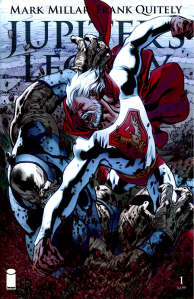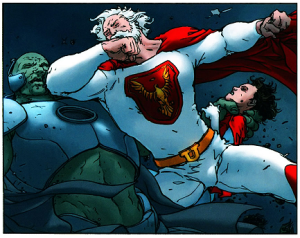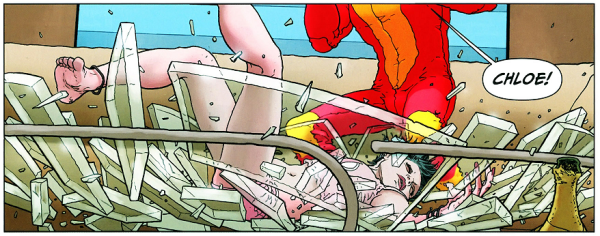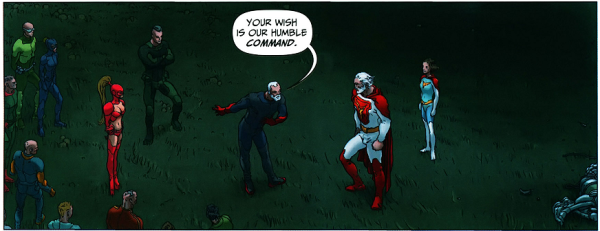
It started with a dream — a beckoning voice that guided a group of idealists to a mysterious island where they were given immense power.
A team was formed and the group used their collective powers to fight for America through the second World War, bringing the nation out of the Great Depression and helping it become the world’s greatest super power. They didn’t fight for fame or fortune — they simply wanted to make the world a better place.
Eventually, the superheroes had children, each with superpowers of their own.
Jupiter’s Legacy begins in history, but it takes place in the here and now, catching up with some of the superhero progeny attending a charity event in Los Angeles. Brandon Sampson, who counts super-sensitive hearing as one of his powers, catches word he’s lost two more high-profile endorsements — Samsung and Omega — as he and his entourage discuss the current and declining state of supervillains. On the other side of the country, a major rumble nears conclusion as a hundred heroes converge to stop Blackstar, a villain who supposedly wiped out an entire alien race.

The fight’s conclusion marks the beginning of another as the Utopian and his brother argue over points they’ve obviously tangled over before. The bickering gives each man a chance to declare their thoughts and reasoning — Sheldon, the Utopian, stands as this comic universe’s Superman. He knows his role as a superhero and maintains a position of political neutrality as long as he stands for America. Walter, on the other hand, has grown impatient with the politicians who he blames for the country’s current economic state.

Wouldn’t it be better to take control of the White House with a greater influence? If they have the power to change the world, shouldn’t they use it — even by force?
Questions like that make Jupiter’s Legacy a comic title with incredible depth. It’s interesting that Mark Millar has rooted his characters in two different eras that are remarkably similar considering the context. The story begins during an economic calamity, which was the jumping off point for the Utopian and his crew who launched their efforts to save the world. As their children deal with modern issues and a new economic crisis — the mortgage crash — readers get to see how times have changed, and what kind of viewpoints bear witness to the world.
It’s not clear whether Jupiter’s Legacy will focus more on the children or the adults, but the contrast between the two sets of heroes is highlighted in how the new breed of heroes functions in society. Brandon takes advantage of his fame to score endorsements, but he finds the quest for fame a tiring one that needs constant work. Popularity equals cash, which is a motivator, and it sets Brandon and his sister apart from his parents who consider their responsibilities with a sacrificial mindset instead of a self-serving one.
The issue ends as Chloe hangs out with friends. It’s a contemplative scene that reveals her flaws by way of her perspective. She may be a star, a privileged superhero living her life in the public eye, but in the light of the perfection she sees in her parents, Chloe can’t help but feel broken. When she overdoses and crashes through a glass table, her friend asks: “Are you okay, hun?”

That question may be the most important one, and the one Millar wants to explore as Jupiter’s Legacy looks like a vehicle to discuss the current state of America — its fascination with celebrities, its divided nature, and its position in the world. In this modern age where technology and medicine have advanced more than leaps and bounds, are we humans better today than they were then? We can look back on the greatest generation and study history, but what if they were all alive and well, willing and able to change the world?
Would they?
Should they?
Millar’s text gets help from a familiar source — co-creator Frank Quitely who contributes pencils — and the chemistry is amazing. Quitely’s art captures the classic superhero persona in the Utopian’s face, and his character designs deliberately place the old and new heroes in contrast by dress. The classic heroes sport capes, shields on their chests, and costumes that cover their bodies, much like the comic book heroes of the golden age.


And perhaps as a shadow — or maybe even a critique — the modern heroes of Jupiter’s Legacy dress themselves in brighter colors with the women costuming themselves in skimpier outfits.
Jupiter’s Legacy feels like a heavy book. Characters discuss Obama, religion, and sex. It isn’t clear — at least to me — if Millar wants to play judge, jury, or advocate. Maybe Jupiter’s Legacy is a mirror reflecting society, and Millar merely wants to give ground to a discussion.
There’s a classic feel to the issue, and the co-creators seem mutually invested. The best parts so far happen between the lines — as the heroes fight to take down Blackstar, Walter locks the foe in subconscious space.
“I think Sheldon’s hitting you with a car right now.”
The scene is a peaceful one — a place Walter created from a pleasant memory.
“I think they just snapped your back-bone.”
Jupiter’s Legacy #1 (2013)
Image
Words: Mark Millar
Art: Frank Quitely
Colors: Peter Doherty
Letters: Peter Doherty
Next Issue: Jupiter’s Legacy #2 Review


Leave a comment